OPMGs
One Piece Merchant Gilts
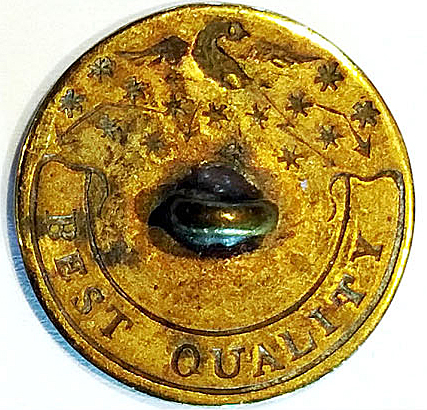
My passion is to study flat gilt civilian buttons made during the late 18th and early 19th century. Using the resources of the era, such as bill heads and industry advertisements, I am able to cross-match the button’s reverse maker signature to other period relics such as tokens in order to reveal the true identity of the maker. This also helps me tightly date the year of production. Below is be a sampling of my research into these lesser known merchants who produced commonly found dandy design or plain obverse gilt buttons.
I nicknamed them: OPMGs-One-Piece Merchant Gilts
I monitor most of the online metal detecting websites in order to create a listing or index of unknown button manufactures for one-piece flat gilt buttons. For each questionable or unidentified button manufacturer I use a forensic style methodology in order to quantify the information in a format that others collectors will be able to use in their research. I measure button blank thickness, button shank wire thickness and type of shank, diameter, the finish or coating if any I.E., Gilt /Plated or lacquered , any proprietary pictorial symbols, and weight. Eventually when I record a closely dated baseline of Button-maker marked buttons , and the OPMGs, as well as standard Quality marked buttons, and comparet them , I may be able to narrow down the dating of Plain Gilt Quality marked buttons by physical characteristics. The late 18th and early 19thc were times of explosive technological growth, the metal rolling technology and other button making technologies changed every few years, the button blank thickness increased from the late 18thcentury as the button diameter decreased. I believe, that if I aggregate enough closely dated data in the spreadsheet trends will emerge. I already have identified 5 makers of the OPMGs by physical characteristics, and I am sure as my information grows, I will be able to refine dating to provide at a minimum a “no earlier than” date for collectors, diggers and archeologist. It might not be possible , but I believe it is doable. This project will fill a gap in the documentation of buttons commonly found in North America. Some of these buttons can be dated to a one or two year period.
Robert Milburn’s Note: Nothing came into the United States from England Starting about 1808 due to the US Embargo except for a very short period during 1810, however, English button makers (and other producers) , hoping for a short war and re-start of commerce continued producing goods and buttons for the US market for several years after 1810. All of that production was dumped on the US auction market about 1816 even though they were produced in about 1810-1813, so, new old stock hit the market in 1816 and was distributed across the US by country merchants buying in New York. Tice Dates the BEST Eagle button 1810-1820 for that reason, most were probably manufactured earlier but not sold till 1816.
Civilian Button Backmark Dates
The Best Quality button is the earliest 1790-1810
The Eagle back (Star) BEST (Star) Button is 1810-1820.
Here is an example of an entry for one of the currently unlisted OPMGs: I have completed about 125 dating/documentations of unlisted merchant marked plain flat gilt (and some plated) buttons at this time.
Chance, W & G, (1820-1828), Hardware Merchants, Listed in the New York city directories and the NY Evening post for years cited. William Chance of Birmingham and his brother George Chance of New York, trading as the firm W & G Chance. George was the front man in NY for Importation and sale of Birmingham hardware goods of all sorts, his brother worked the business end in Birmingham England, they are noted for the locks of their trade rifles and pistols which were used in the fur trade and various conflicts. They also imported and sold large quantities of gilt Birmingham buttons under their backmark and had quite a few B/M variations The firm announced the dissolution of their partnership in the NYEP, 28 Jan 1829, the partnership was actually dissolved 31 Dec 1826 by mutual consent, but they continued trading in the US and were listed in the NYC Directory until 1828
.Recorded Backmarks:
W & G Chance/Extra Rich
W & G Chance/Extra
W& G Chance/Fine Stande
W & G Chance/(Six point star) Imperial (six point star)
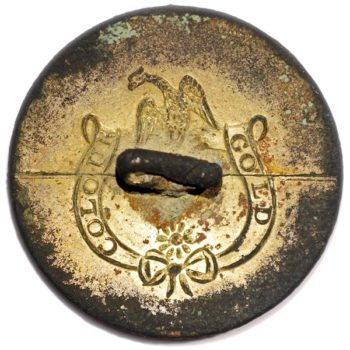

1792-1810 Civilian Dandy
Colour: Gold W/ Green Encrustations
Metal: Flat, 1-Piece, Raised Design, Gilt Brass
Maker: Matthew Boulton’s Soho works
Production Origin: London for American Market
Robert Milburn’s Notes: The button attached is very interesting, to my knowledge it, or one similar by the same maker, has never been identified as to the identity of the maker before. This button is a product of Matthew Boulton’s Soho works. It was made prior to the Metal Button Act of Parliament, (1796), 36. 3. C. 60, of which, Mr. Boulton was the main driving force. Prior to the act these buttons bear quality marks, after the passage of the act the same buttons bear standard marks. This is a key transitional period button (some say 1795-1810 on the transitional dates), but I believe it is earlier about 1792. I have been seeking other examples and just secured a Double Gilt version, I have seen a Treble Gilt version with a different basket pattern and Tice listed a Treble Plated version in a large basket weave pattern. Mr. Tice did not know these were made by Boulton. So folks will see it first on your site. I assume a (Single) Gilt Version but I have not observed one. I have a list of 4,000 backmarks dug in England and also searched the UKFD finds database, to date I have not heard of any buttons matching this backmark profile dug in the United Kingdom, so these seem to have been manufactured solely for export to the United States. I should add at this point, that these button are quite scarce, most I have seen have been found on early sites in Virginia. All told, in book and online, I have seen less than 10 examples. Matthew Boulton had the familiar registered silver Maker’s Marks,”MB”, but he also a registered maker’s mark called a “Device Mark”, in Henry Newton Veitch’s History of Sheffield Plate, 1908, Matthew Boulton’s device mark, registered in 1784, was “The Sun”, sometimes used without the firm name. Most of the early transitional buttons had backmarks consisting of only a single capital letter or a set of capital letters a few of these have been identified, but a number remain obscure.
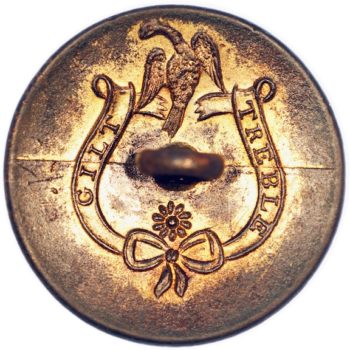
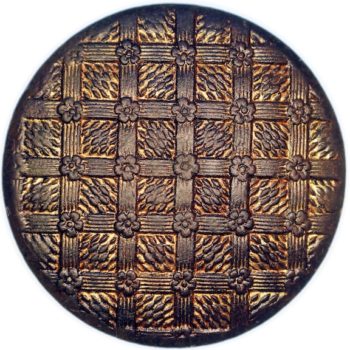
Treble Gilt Matthew Boulton, Ribbon, Bow & Eagle Button
1792-1810 Civilian Dandy -Treble Gilt with Eagle, Ribbon, Bow and Sun Backmark
Colour: Gold highlight with Chocolate brown base metal showing through the gilt which has been deteriorated by ground action.
Metal: Low Convex, 1 piece, Copper Alloy Gilding Metal, raised design of a Basket pattern accentuated by floral design at the junctures of the basket weave. A spectacular impression of an Eagle graces the back of the button, looking more akin to a Dragon, this eagle had yet to be gentrified to the sleek American version we take for granted today. This button bears a split or clam die seam, commonly but incorrectly named a split anvil line (SAL), (Split or clam dies were the actual terminology used by the period button manufacturers-I will provide citations upon request). This button is not a Re-used plain gilt as are many with a seam, but rather, in certain high-quality buttons of this period particularly military and livery button, the shank was attached before the impression was struck, and the clam dies /split dies or a die with a hollow recess for the shank was used to protect the shank from damage. On some buttons, this seam was polished out, but on many button, it was left be.
Maker: Matthew Boulton’s Soho works
Product Origin: London for the American Market
Robert Milburn’s notes: This button is an extremely high quality late 18th century gilt metal button. The button blank thickness is approximately double the average dug Colonial button commonly excavated in North America. The Testament to the high quality of the button’s construction is the amount of gilding remaining after being subjected to ground action and fertilizer for more than 200 years. This button was manufactured after passage of the Metal button act of 1797, as it bears the standard marks of Treble Gilt. Matthew Boulton was a key factor in the passage of the act which was developed to prevent the destruction of the lucrative Gilt Button Trade in England. In the 1790s, it was the wild , wild west for standard and quality claims, Dipped (dipt) buttons had been developed in the 1790s, which produced a beautiful gold colored buttons completely without the use of gold (Chemical salts, lacquers and various chemicals were used to color the brass of dipt buttons) , but the Dipt buttons faded in just a few weeks, the public became wary of buying gilt buttons which threatened the trade, thus the metal Act was developed, proposed, campaigned for and passed with the help of the King and Parliament which set standards for the production of true Gilt buttons which used real gold. Thus, the Standard marks of Gilt, Double Gilt, Treble Gilt and Plated for Silver Buttons were applied to allow the public confidence in the purchase of Gilt and Plated buttons.
Of course, these type of “sumptuary laws” only worked for a short time, and only kept the honest people honest. So…. what you do when somebody marks their buttons “Really Great Strong Gilt”, are you going to call the “button police”, are there any actual “button police”? these questions and more will be answered in the next installment of ….” Interesting facts about very boring plain flat gilt and plated buttons with nothing interesting on the face”.
The Button Bobbies…lol
The London police were called “bobbies” after Peel; the diminutive for his first name, Robert, is “Bob,” hence the nickname for the London police. Another story says that the cops of that time were paid a “bob” in salary each week. A bob being slang for a shilling, a form of British currency.
Birmingham Button Association
GILT AND PLATED BUTTONS. July 8,1799.—The Committee of the Button Association hereby give Notice, that a Reward of Ten Guineas will be paid by Mr. Simpson, Cherry street, Solicitor to the Association, upon Conviction, to any Person or Persons who shall give Information against the Makers or Vendors of Metal Buttons that are gilt or marked contrary to Act of Parliament, and the name of the Informer will not be made known.
Robert, I have a lot of very interesting and sometime humorous information on the “button police.” My archives of newspaper ads have segments where they are asking for snitches to provide info for cash, no questions asked……. When I started digging up buttons, and I started seeing all sorts of outlandish “quality touts” as the Brits call them, and then I read about the “Metal Button Act”, I kept asking how come they let everybody put anything they wanted on the back? What about the regulations?
Then, I remembered in the Army we only enforced the Regulations we were FUNDED for. If we did not have the manpower or the funding to enforce or enact a particular regulation, we said, oh well……if the ARMY wanted us to enforce it they would fund it. Same with the Brits. The magistrates and customs officials were not funded to enforce the Metal Button Act, it was up to the Birmingham Button Association to bring the case forward, pay the INFORNER (yes that is another reason it did not work, figure out the life expectancy of an English Gilt button squealer in Birmingham in 1820…..not long.) Add to that the fact that England actually state sponsored dumping on the American auction market after the War of 1812 to “Strangle American Industry in its cradle” a quote from deliberations in Parliament, so customs officials would look the other way on anything foisted on the American Market and you get lip service paid to the Metal Button Act. Lots of other factors mitigated against the act, the state had to prove that the button seller “Knew that the guilder did not gild to standard” this was a near impossibility and led to many dismissals.

SHAW & PATTERSON, DRY GOODS MERCHANTS, BOSTON, MA: (1829-1831)
BACKMARK: SHAW & PATTERSON/(Dot) Five Point Star (Dot) BOSTON (Dot) (Five Point Star)// (3 Five Point Stars) EXTRA (3 Five Point Stars) RICH
The firm of Shaw & Patterson, Boston, was formed in 1829, partners were: Charles B. Shaw & David Patterson, Dry Goods Merchants listed at 13 Central St. (1829-1831). In 1832 the firm became Shaw, Paterson & Co., with the addition of William Blake, the firm was listed as Dry Good Merchants at 13 Central St. (1832-1833), and at 67 Milk St. (1834-1835), in 1836 the firm took on an additional partner, M. J. Mandell, listed as Dry Goods Merchants at 67 Milk St. (1836), and 93 Milk St., (1837-1839). In 1840 Shaw, Paterson & Co dissolved and the firm continued as Shaw, Blake & Co. (Charles B. Shaw & William Blake) Listed as Dry Goods Merchants at 93 Milk St. Reference: Stimson’s Boston City Directories 1831-1840.
Obverse: Plain Gilt
Size: 21 mm
CONSTRUCTION: This is a Flat, Plain Face, One-Piece Gilt Button. It is made of brass, it is non-excavated, in good condition retaining approximately 90% of the original Gilt finish, from comparison of proprietary marks in my research archive, I have identified this button as a product of Robinson, Jones & Co. of Attleboro, MA.
SHAW, PATTERSON & Co., DRY GOODS MERCHANTS, BOSTON, MA: (1832-1839)
BACKMARK: SHAW PATTERSON & Co./(Dot) BOSTON (Dot)// (2 solid concentric rings around the shank)
The firm of Shaw & Patterson, Boston, was formed in 1829, partners were: Charles B. Shaw & David Patterson, Dry Goods Merchants listed at 13 Central St. (1829-1831). In 1832 the firm became Shaw, Paterson & Co., with the addition of William Blake, the firm was listed as Dry Good Merchants at 13 Central St. (1832-1833), and at 67 Milk St. (1834-1835), in 1836 the firm took on an additional partner, M. J. Mandell, listed as Dry Goods Merchants at 67 Milk St. (1836), and 93 Milk St., (1837-1839). In 1840 Shaw, Paterson & Co dissolved and the firm continued as Shaw, Blake & Co. (Charles B. Shaw & William Blake) Listed as Dry Goods Merchants at 93 Milk St. Reference: Stimson’s Boston City Directories 1831-1840.
Face: Plain Gilt
Size: 16 mm
Construction: This is a Flat, Plain Face, One-Piece Gilt Button. It is made of brass. It is non-excavated, in good condition retaining approximately 90% of the original Gilt finish, from comparison of proprietary marks in my research archive, I have identified this button as a product of Robinson, Jones & Co. of Attleboro, MA.
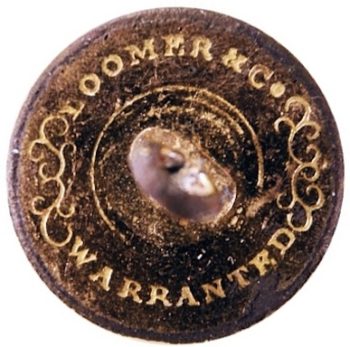
OTIS LOOMER & Co., DRY GOOD MERCHANTS, NEW YORK: (1825-1832)
Backmark: Otis Loomer & Co./Warranted/ Decorative Scroll Flourishes on either side of the shank; traces of three concentric rings circle the shank.
The firm of Otis Loomer & Co. was formed in New York City in the year 1825, partners were Otis Loomer & James C. Bates, they were Dry Goods Merchants at 189 Pearl St., NY. The partnership dissolved in Jan 1827, with James C. Bates leaving, and Otis Loomer carrying on alone at 189 Pearl St., under the original firm name of Otis Loomer & Co. until August of 1832 when the business failed. Reference: ( 1.) Longworth’s New York City Directories for the years 1825-1832. (2.) New York Evening Post (Herinafter referred to as the NYEP), 31 Jan 1827, Announcement of Dissolution of Partnership of Otis Loomer & Co. , 29 Jan 1827, Otis Loomer & James C. Bates. Otis Loomer will carry on business alone at 189 pearl St.
Face: Plain Gilt.
Size: 20 mm.
Construction: This is a Flat, Plain Face, One-Piece Gilt Button. It is made of brass, it is an excavated button and was found in Virginia. The button blank is eroded and pitted by ground action, but gilt remaining in the recesses of the impressed backmark renders it easy to read. Maker is currently undetermined.

Robert,
Attached is a picture of the most rare “Eagle Back” in my collection of those types. Very interesting design, I have only seen the Lightning bolts from the talons on one button design 1808-1817 Diplomat Button. Eric Reichardt who has handled hundreds of thousands of buttons said it was one design he had not seen on any flat button back before. He had seen all of the other patterns I collected. Bob

The button was made between 1816-1825.
Lewis & Tomes is one of the English Companies that had dates that are a bit off in the references, again due to lack of references when they were originally researched.
Lewis & Tomes was actually in business from 1816-1825, Francis Tomes bought out Edward Lewis’ share of the firm in 1825 and the partnership was dissolved.
They actually never made a button, they had them made for them like William Wallis. Tomes traveled to America in 1816, he was not listed until 1819, hence the date of 1819 in M & B, he was however listed in the Birmingham Directory of 1816 , Lewis & Tomes Merchants, Regent-Place, as well as the Birmingham Directory listing for 1818 at the same address.
John Spencer (1799-1827), and later William & John Spencer (1828-1837), Birmingham, England, Merchants, Factors, Gun & Pistol & Button-Makers. John Spencer is first listed in the 1800 Bissett’s Grand Copper Plate Directory of Birmingham, on engraved plate “D”, as a merchant and on plate “E” as a Gun Maker. According to Birmingham Gun-maker references (See note) He was working as John Spencer, Loveday Street, Birmingham 1799-1806, and subsequently as John spencer & Co. 1807-1817.
From 1817-1826 he was working again as John Spencer at 7 St. Mary’s Row. In 1828 the Birmingham Directory listings changed to reflect his brother William joining the firm under the style of William & John Spencer, Button-makers, (gilt & plated), 7 St. Mary’s Row, they were also listed as Gun & Pistol makers at the same location. From 1828-1837 they continued to be listed in the Birmingham Directories as both Gun & Pistol & Button Makers at 7 St. Mary’s Row. The firm was not listed after 1837.
************* R. ************* B. *************
************* 11/11/18 *************
Unlisted English Button maker: One-piece buttons back marked with the name: “SPENCER”
 Button backmarked “SPENCER”, Incised Mark, GREEK KEY MOTIF 21mm, Plain Face, A-Shank
Button backmarked “SPENCER”, Incised Mark, GREEK KEY MOTIF 21mm, Plain Face, A-Shank
This is a new unlisted Birmingham English Button-Maker. In a few of the Massachusetts digger collections, my friends have let me go thru, I discovered an early, “A-Shank,” plain faced, one-piece button 21mm, back marked “SPENCER”, with a GREEK KEY Motif.
 Button backmarked “Treble Gilt Standd”, Incised Mark, GREEK KEY MOTIF, 21mm, Plain Face, A-Shank, I believe it was made by SPENCER
Button backmarked “Treble Gilt Standd”, Incised Mark, GREEK KEY MOTIF, 21mm, Plain Face, A-Shank, I believe it was made by SPENCER
I found one that appeared to have come from the same maker, without the backmark, but with the same GREEK KEY Motif. Subsequently, I found, in an old Massachuetts collection, a non-excavated early CROWN type one-piece plain faced button backmarked SPENCER. So, I decided to pin down who this maker was. I found him in Birmingham, England; John Spencer (1799-1827), and later William & John Spencer (1828-1837), Birmingham, England, Merchants, Factors, Gun & Pistol & Button-Makers.
 Button Backmarked “SPENCER”, Raised Mark, Saint Edwards Crown, 24mm, Some gilding remains, Plain Face, A-Shank
Button Backmarked “SPENCER”, Raised Mark, Saint Edwards Crown, 24mm, Some gilding remains, Plain Face, A-Shank
I would expect to find these buttons excavated at early sites on the US East Coast. Spencer was a merchant, and also engaged in the American shipping trade, so in addition to the Guns and Pistols he imported into the US, he may also have included buttons, gilt & plated.
Based upon construction, I believe the buttons I have found date between 1800-1820.
Robert Milburn’s Notes: Reference for the 1799 founding date is; English gunmakers- The Birmingham and provincial gun trade in the 18th and 19th Century, pg. 53, by De Witt Bailey, Douglas A. Nie, Arms and Armour Press, 1978
References for the Birmingham Directory Listings:
1800 – Bissett’s Grand Copperplate Directory of Birmingham for the year 1800, plates D & E
John Spencer, listed as a Merchant of Birmingham on Plate D, and a Gun Maker on Plate E
1815 – Wrightson’s new triennial directory of Birmingham for 1815, pg. 120, 1815
John Spencer, Merchant, Gun & Button-Maker, Loveday St.
1816 – England Commercial Directory, 1816-1817, Birmingham Listings pg. 29,
John Spencer, Merchant, 31 Loveday St.
1818 – Wrightson’s new triennial directory of Birmingham for 1818, pg. 122, 1818
Spencer, John, Merchant & gun maker, St. Mary’s Row
1822 – History, Directory & Gazetteer, of the County of York, Volume 1, pg. Lxxxii, By Edward Baines
Spencer, John, Gun & Pistol Makers St. Mary’s Row
1825 – Piggott’s National Commercial Directory of Scotland, Birmingham Listings. 1233-1374.
Listed as a Button-maker, Factor, Merchant & Gun & Pistol Maker, 7 St. Mary’s Row
1828 – Piggott’s National Commercial Directory of England, Birmingham Listings.
Spencer Wm. & John, listed under Button-makers, as (gilt & plated), 7 St. Mary’s Row, also listed as Gun & Pistol makers; Spencer Wm.& Jno.7St. Mary’s Row
1830 – The History, Topography and Directory of Warwickshire, pg. 389, by William West, Published by R. Wrightson, Birmingham, 1830
William & John Spencer, listed as Gilt & Plated Button, Gun & Pistol Makers, Factors & Merchants, 7 St. Mary’s Row.
1835- The Directory of Birmingham for the Year 1835, Wrightson & Webb, Birmingham
William & John Spencer listed as Gun and Button-Makers, St. Mary’s Row
1837 – Pigott & Co.’s National Commercial Directory of Scotland, London; Birmingham Listings
William & John Spencer listed under Button-Makers and also under Gun & Pistol Makers, at 7 St. Mary’s Row
************* R. ************* B. *************
************* 11/20/18 *************

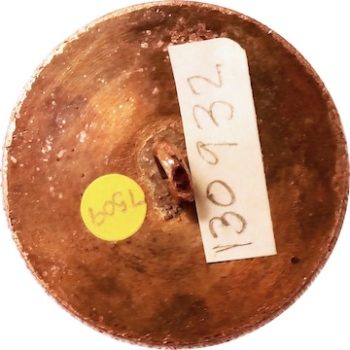
Pictured above and below are five fine gilt buttons made 16 August 1786 in Birmingham England by Button-maker Thomas Green. They are part of a sample case of 96 buttons, also known as a pattern card, or salesman’s sample, which was discovered in France in 1951, by George Ertell, a noted Antiques and Button dealer. He brought them back to America where they were display at the Annual National Button Society Convention, Chicago in 1952.
The case is signed on the inside “IG – From Joseph Green, Birmingham – Card No 5362”, and another inscription “IG Card No 5362. Fine Gilt Buttons”. Joseph Green was a Merchant of Birmingham working with Thomas Green Button-Maker, both listed in the Birmingham Directories at 25 New Street.


There were 24 buttons each, arranged on 4 folding pages. All of the button blanks appear to have been made from wrought Gilding metal (95% Copper, 5 % Zinc). All of the buttons were flat gilts, with brazed Alpha-Shanks. None of the buttons were cast or die stamped, all were formed by a combination of chasing, engraving and the use of various punches. A mix of different colors or shades of gold, silver and gunmetal were used to finish the buttons. All were in untouched condition.


After the 1952 NBS Convention, the case disappeared from public sight for 29 years, and reemerged in October of 1981 in the Collections of Margaret Woodbury Strong of New York, who passed in 1969. She was a wealthy collector of Antiques and also had an interest in buttons. The Joseph Green Button case of 1796 was mentioned in an article in the October 1981 National Button Bulletin, regarding the opening of the Margaret Woodbury Stong Museum, per the bequest in her will of all of her Antiques (over 200,000 items) and an endowment of many millions of dollars to build and operate the museum. The museum opened to the public in 1982, it is now known as “The Museum of Play” and is located at One Manhattan Square, Rochester, New York.


At some point, probably in 2007, the Museum board may have decided to deaccession items that were not within the scope of the collection and mission of the Museum.
The Joseph Green Button Sample Case reemerged in June of 2007 in an auction conducted by Page-MBA Button Auctions, Batavia, New York. The buttons were sold in two separate auctions 48 buttons from the case were auctioned in June, and the Case and the remaining 48 buttons were auctioned November 1 & 2, of 2008. Collectively the Case and 96 buttons sold for over $21,000.


The second auction in November 2008 featured 48 buttons and the sample case itself, a very advanced Collector-Dealer, (Name withheld for Privacy -Collector 1) purchased a majority of the buttons and the case.
2007-2011, another very advanced Collector-Dealer (Collector 2), purchased many of the remaining buttons from Collector 1.
2018 – I was very fortunate to have the opportunity to buy 5 of these 18thCentury Fine gilt, “Rare Survivals”.
It appears from the directory listings showing Thomas and Joseph Green co-located at the same business address, that they were related (Probably brothers). It is most likely that Joseph, the Merchant dealt with marketing & distribution while Thomas Green operated the shop that manufactured the buttons.
Birmingham directories from 1767-70 List Joseph Green as a Wine Merchant, 25, New Street
1777 – The Birmingham Directory or Merchant & Tradesman’s Useful Companion pg., 21, Pub; Pearson & Rollason, Birmingham, 1777
Thomas, Green, Button-maker, 25, New-street
Joseph Green, Merchant, Ditto (Same address)
1781 – Bailey’s Northern Directory, or, Merchant’s and Tradesman’s Useful Companion for the year 1781, Birmingham Listings, pg. 150; Pub, William Ashton, Warrington, 1781
Thomas Green, Button Maker, 35 New Street
Joseph Green, Merchant, Ditto (Same address)
1785 – The Button Making business, became Green and Vale
1788 – Birmingham, The Distant Trader’s Guide & Local Resident Directory, Pg., 18, Pub; G. Hunter, Birmingham
Green & Vale, Button-makers in General, 25 New Street
1793 – The Universal British Directory of Trade, Commerce, and Manufacture
Barfoot & Wilkes Pub; 1793
Green & Vale Button-makers in General New-street
Joseph Green, Merchant, continues in Directory listings to 1797.
1799 – Joseph Green, Birmingham, Merchant, Dealer & Chapman is listed as a Bankrupt in the London Gazette
Joseph Green died at Dalbury, in Derbyshire, on January 28th, 1810
For those interested, and who have access to the National Button Society Digital Archives, there is an Article in the September 1951 National Button Bulleting, with a description of the Card and buttons as well as black and white lower resolution pictures of each page of the sample book. pp., 290-295
************* R. ************* B. *************
************* 11/23/18 *************


Matthew Boulton; GOLD COLOUR, Ribbon, Bow & Eagle Button
1792-1796, Civilian Dandy -Backmark: “Gold Colour” with Eagle, Ribbon, Bow and Sun
Color: Chocolate brown base metal with remnants of Gold gilding on the face in a Basket Pattern, the basket pattern resembles a checkerboard and it appears that alternate squares have been darkened to highlight the pattern. This is an excavated button; recovery site is undetermined. The button has been significantly been deteriorated by ground action.
Metal: Button blank is 25mm in diameter, thickness of the blank is 1.5mm, profile is flat. Blank is Copper Gilding Metal, early alpha braised shank, shank wire is hand drawn half-round, and appears to be copper. Face bears a raised design of a Basket pattern, some Gold gilding remains, pattern features a basket pattern of lined squares with alternate squares intentionally darkened for contrast. A spectacular impression of an early type eagle graces the back of the button. Although this button bears a split die seam, it is not a Re-used button.
Maker: Matthew Boulton’s Soho works
Product Origin: London for the American Market
Robert Milburn’s notes: This button is an extremely high quality late 18th century gilt metal button. I believe that this particular button was manufactured before the Metal button Act of 1797, as after the act similar buttons by the same maker bear standard marks. I.E., GILT, DOUBLE GILT, TREBLE GILT, PLATED.


Matthew Boulton; TREBLE PLATED, Ribbon, Bow & Eagle Button
1797-1810 Civilian Dandy -Backmark: “Treble Plated” with Eagle, Ribbon, Bow and Sun
Color: Dark brown base metal with remnants of “Old Sheffield Plate” silver on the face in a Basket Pattern. This is a button excavated in New York, and has been deteriorated by ground action.
Metal: Button blank is 25mm in diameter, thickness of the blank is 1.5mm, profile is flat. Blank is Copper Gilding Metal, early alpha braised shank, shank wire is hand drawn half-round, and appears to be copper. Face bears a raised design of a Basket pattern in “Old Sheffield Plate” silver. A spectacular impression of an early type eagle graces the back of the button. Although this button bears a split die seam, it is not a Re-used button.
Maker: Matthew Boulton’s Soho works
Product Origin: London for the American Market
Robert Milburn’s notes: This button is an extremely high quality late 18th century “Old Sheffield Plated” metal button. I believe that this particular button was manufactured after the Metal button Act of 1797, as prior to that act I have seen the term “Strong Plated” or “Solid Plated” commonly used in period advertisements and on sales receipts. The mark of Treble Plated is an attempt to adhere to the required standards of the act. I have seen a Sheffield Plated example posted on Treasure net forum which bears the backmark “Solid Plated”, that I believe, was manufactured prior to the passing of the Metal button Act.
************* R. ************* B. *************
************* 12/03/18 *************
1820’s Thomas Porter II Slave Trade Coat Button
Metal: Flat, 1-Piece, Raised Design, Brass.
Size: 19.59mm. Coat Size.
Maker: K & Haydens.
Bob’s Notes: Thomas Porter II was a slave trader in the early 1800’s. This button was not for the field hands, this button would have been for a house servant in livery, or possibly for an Overseer. All Porter buttons all come from British Guiana, called Demerara at the time, a great many of the Plantation owners there were English and many were Scottish.
Collector’s Note: There is also a very early 2-piece TP, back mark and is Patent Gold Plate, also dates to early 1820s (1820-1822)
************* R. ************* B. *************
************* 03/11/18 *************
*


1797-1810 Civilian Transitional Period Button: Backmark “Treble Gilt” with Eagle, Ribbon, Bow and Sun
Color: Brass Yellow.
Metal: Gilt Brass or Copper.
Size: 25mm in diameter, thickness of the blank is 1.5mm, profile is flat.
Robert Milburn’s Notes: This button is the second non-excavated specimen of this type I have observed. I have seen one other, which is a Treble Plated Basket Button, with Eagle, Ribbon, Bow and Sun. That button is in the Winterthur Collection and was found in the “Relic Box” of John Fanning Watson (1779-1760), John Fanning Watson was a Philadelphia antiquarian and amateur historian who became a professional writer. He is best known as the author of, “Annals of Philadelphia”. I believe that this particular button was manufactured after the Metal button Act of 1797, as prior to that act I have seen, on similar buttons the term “Gold Colour”. After the metal Button Act took effect, the standard marks of Double Gilt, Treble Gilt, and Plated are seen on button of this make.
The face of the button, bears a raised design of a Basket pattern, the button is gilded with some nominal wear with the base metal being showing through on the high points of the button. The reserve has a raised design showing very little to no wear. This button has a split die seam, but it is not a Re-used from old left over stock.
Process: This button was shanked prior to the impression and raised design being stamped upon the front and the back. Most likely the button was struck in a split die, (also known as clam dies), with a cavity to protect the shank from damage. The split-die seam line on the back of the button was made by the slight space existing between the edges of the split die. This button is an extremely high quality late 18th century gilt metal button.
Maker: Matthew Boulton’s Soho works, the back of the button bears Boulton’s device mark, “The Sun”
Product Origin: London for the American Market
Reverse Construction: One Piece alpha Loop shank with braised half-round, hand-drawn copper wire.
************* R. ************* B. *************

************* IIIIIIIIIIIIII **************
Spanish Civilian Cashe
I recognize the cache of buttons in the picture as Spanish in origin , dug in Spain and sold commonly on eBay, these sales have increased greatly in the last few years. The poor folks with their economy in a nose dive, have taken to selling their heritage in the form of pounds of buttons for pennies on the dollar. 15 years ago that trove of buttons would have brought hundreds, they are treasured when dug up in St. Augustine Florida, but so common in Mother Spain.
What I am looking for are the plain flat gilt and plated buttons commonly found in collections, archeological digs and digger’s collections, recovered in North America. Attached is a picture of three nice examples of these one piece plain gilts bearing American merchant firms on the blackmarks. The first to use this style were the American hardware Merchants late 1790s -1811 and then again 1816 after the war they who imported mostly Birmingham goods, next came the Tailors of Bespoke Clothing, and then finally the Dry Goods Merchants in the latter 1820s. to about 1836 when this style ceased on plain flat gilt buttons. 80% of the ones I have physically located came form buying very old accumulations from collections of the 1940s-1950s, the other 20% have come thru combing of thousands of dug buttons from my friends and also from monitoring the I.d. request on all of the forums.
I have been ferreting out and collecting, sometimes buying digitized directories of the major cities in the US for about 7 years, I have almost every directory from the late 18th century to 1866 for New York, Boston, Philadelphia, Baltimore and scattered directories from other cites as well as national directories. Also most London, Sheffield and Birmingham Directories. I can date a merchant Blackmark from start to finish in most cases in about 2 hours-longer if no place name is on the backmark and full name sinstead of initials are used for the first name. My research can prove useful to refine the date on many buttons with designs as many of the civilian dress buttons were RE-used by American makers to create their buttons, so by comparison you can attain a “no earlier than date” for a uniform buttons on a RE-used civilian dress button.
I do not care if the button is dug or non-dug as long as the backmark is legible. The knowledge is the thing. I intend to keep the study collections intact for later analysis.
I am also interested in the metal Transitional buttons 1790-1810 with mostly initials or symbols for Blackmarks I.e., “K”, S in a dotted circle, I M & S, CF & K, WR & S, those with mostly dot and diaper basket type fronts thin blanks alpha shanks the latest having Omega shanks, and Eagles that look like dragons with scaly necks and ribbons and bows, Strong gilt, Treble gilt, gilt, Strong Plated etc.
I have documented most of the makers CF & K is known as I WR & S but IM & S and K and S are not recorded in the major references.

